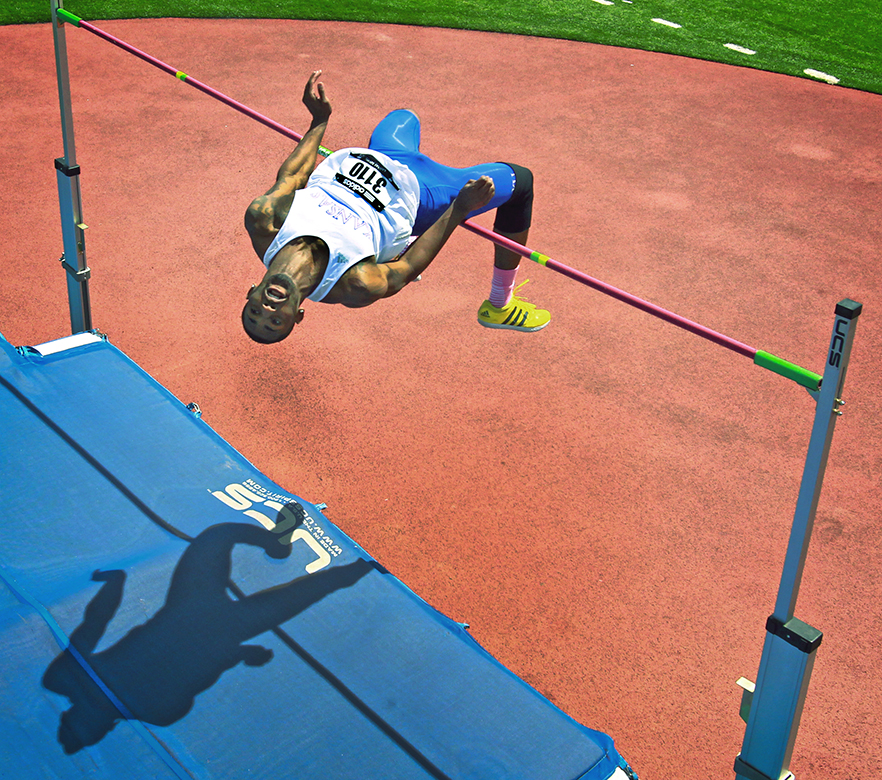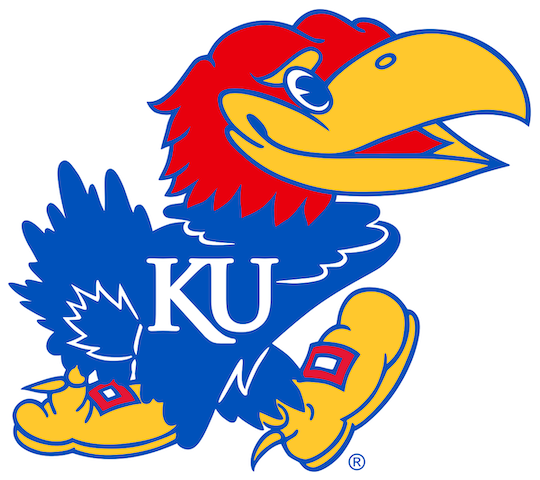📸 Through The Lens | High Jumping
Kansas Athletics staff photographer Jeff Jacobsen shares his memories of what he saw “Through the Lens” from his 23-year career with the Jayhawks.
In the second of three stories detailing photographs I have taken from past Kansas Relays, my attention is turned to what I believe to be the most beautiful singular move in sports, the high jump. To watch a man or woman clear a height in the high jump is something both powerful and stirring. Clearing a height takes seconds, but in those seconds, the emotions of onlookers are heightened by the grace and beauty. You want to marvel over the next jump again and again.
The history of the high jump began with the “Scissor Kick,” where the lead leg extended over the bar with the trailing leg snapping over in a cutting action, much like real scissors. The “Western Roll” followed with the lead leg arching up and over the bar as the torso began to roll over the bar face down with the trailing leg following. With landing pits nothing more than sand, straw or wood chips, these were the two safest forms of high jumping. As padded landing pits developed, a revolution found its birth in Medford, Oregon.
A 16-year-old high school sophomore, Dick Fosbury, began launching himself over the bar with his head and torso backward in 1963. His legs kicked simultaneously together over the bar. A photograph in the Medford Mail-Tribune captioned “Fosbury Flops Over Bar” gave the new jump a name now universally recognized as the “Fosbury Flop,” which as a photographer makes me proud.
After winning the 1968 Olympic high jump, Fosbury was announced as one of the competitors at the Drake Relays in Des Moines, Iowa, held the week after the 1969 Kansas Relays. My parents graciously allowed me to miss school in my senior year of high school to drive my Volkswagen Beetle to Des Moines.
On a beautiful sunny April day, friend Ron Torrence and I watched Fosbury win the high jump title with mesmerizing ease. Fosbury’s flopping was such a draw, fans were allowed to encircle the jump area to view the spectacle.
That night with suitcases, furniture pads and pillows stacked on the edge of one the beds inside our Holiday Inn hotel room, Torrence and I took turns “flopping” as best we could over make-shift heights. With each jump, we laughed endlessly.

Naturally, as I began my photography career in May of 1969, I was drawn to the event that forever remains a favorite except for one factor. Photographs of a jump soon became repetitious to me. In almost everything I photograph in sports, there is a “pack mentality” where groups of photographers will stand together on either side of the high jump pit and continually take the identical photograph. I have done it often, either out of need or out of restrictions as to where I might go to do something different. That soon drives me crazy. As it is said, “Hacks travel in packs.”
The Lord’s blessings have allowed me to photograph so many incredible high jumpers in my career and years at KU. However, since this story is about events from the Kansas Relays, I will single out one high jumper in two examples to show my efforts to capture something more than the standard photo.
Johnathan Fuller became the first KU high jumper to clear seven feet in nearly a decade with a jump of 2.15 meters (7-00.59 ft.) at the 2012 Kansas Relays. Fuller loved having his picture taken and always made sure to speak to me after the event to make sure I had captured something different.
For that 2012 clearance, I discussed with the officials before the event my desire to make a photograph with a 35mm lens from right behind the pit while laying down low enough that the jumper would never see me as he ran in for takeoff. I demonstrated how I would pop my head and camera up only as Fuller took off. My goal was to capture Fuller set against the always gorgeous view of “The Hill” leading up to KU’s iconic Campanile. Thankfully they agreed.
There is a peak moment when an image comes together as hoped and planned. Fuller’s relaxed face, even though he still needed to get his legs over the bar, said to me he knew he was going to clear the height.
“The movements are so sleek, sophisticated and graceful,” my friend, co-worker and track & field fan, Erin Penning, recently said. “That’s what comes to my mind when picturing one of your high jump photos in my head.”

The second image of Fuller was made 364 days later in KU’s new track & field facility, Rock Chalk Park, in west Lawrence. On a broken pole vault crossbar given to me by KU’s vertical jumps coach, Tom Hays, I clamped a camera to one end, taped off the lens at the best focal length, and triggered the shutter release with a remote.
With the permission from event officials again, I held the bar over my head leaning in just enough to capture another different angle of Fuller clearing a height. I tested the setup often before the event to make sure I knew the aspect I wanted and how the camera should be positioned as I alternately stared up into the sunny sky and at Fuller beginning his attempt.
My hope is you get a sense from these images the extent to which I will go to make a unique picture and that you can appreciate better the beauty that is the high jump as I close with one more cherished high jump moment.
In January 1998, my first year working for KU, the legendary Wilt Chamberlain returned to KU for a jersey-retirement ceremony. He hadn’t been back to KU since leaving in 1958. Following a press conference the day before in Hadl Auditorium, I was asked to escort Chamberlain to the men’s basketball locker room for a photograph of coach Roy Williams and the team.
I was overwhelmed by the honor, and size of the remarkable man, but he quickly put me at ease by asking about the Kansas Relays. Chamberlain possessed a love of track & field that some say was greater than his love of basketball. As we neared the locker room, the three-time Big 7/8 high jump champion stopped me in the hall before entering to remind me,
“I was a pretty good high jumper,” he said with a great laugh.
Ah, if only I could have photographed Chamberlain at the Kansas Relays.

